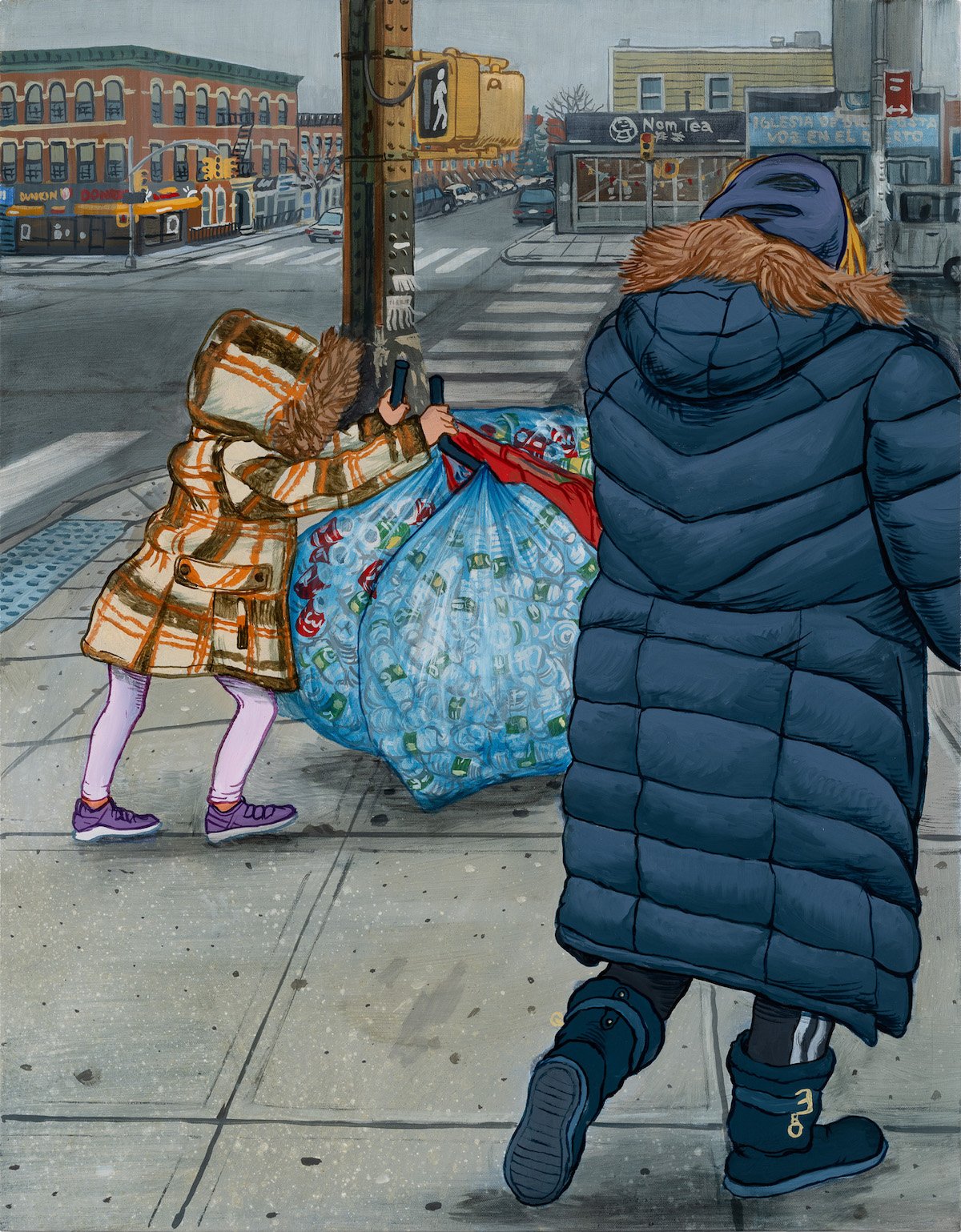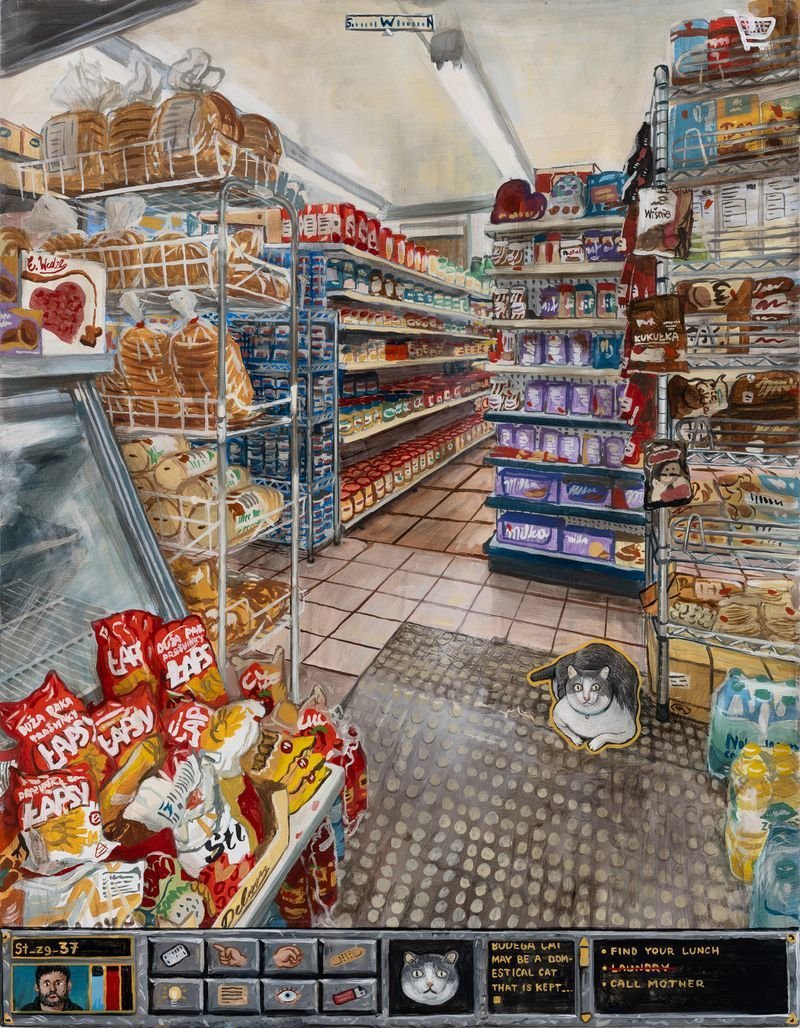Stipan Tadić: To Capture a City
Born in Croatia and raised in Austria, Stipan Tadić’s early experiences as an immigrant influenced his artistic practice and how he portrays foreign cities. From the cultural jungle of New York City to European capitals, Tadić’s art offers an intimate perspective on the human experience within the urban landscape that is both crudely realistic and freshly sarcastic. In this interview for IMPULSE’s Migration in Dialogue conversation series, Tadić discusses how he captures the essence of a space.
Mariado Martínez Pérez: Much of your work is intrinsically connected with the intimate, personal side of being a migrant or visitor in an urban setting. Where does this focus come from? Is it somehow related to your background?
Stipan Tadić: I was born in Croatia (when it was Yugoslavia). When I was three or two years old, we moved to Austria. I grew up as an immigrant there, learned how to speak German and all. This was before the [Yugoslav] Wars, which started soon after we got to Austria.
We went back to Croatia after the war, in 1996 or 1997. But the war still affects you, even when you’re a kid. For me, immigration is a very important topic because I spent my formative years, those “getting set up” years, as an immigrant in a different country. It was there that I started drawing.
MMP: And you decided to pursue art in Croatia when you moved back?
ST: Yes, I went to elementary school, high school, and college, all art-related. By the time I finished my undergraduate studies in Croatia, I was already part of the art world in Zagreb. But I wanted to expand; I saw the art world in Croatia as very locked in. It felt hard to get out of those borders.
MMP: Was that when you considered moving to the United States?
ST: I thought I could do an MFA so I spent some time applying. And everything worked out. I actually got two scholarships, one from Croatia and one from Columbia University.
MMP: So you were fully funded?
ST: Yes, my move to the US was comfortable. I was not worrying about money. If I had to move with my regular income, I would’ve probably stayed in Croatia or gone somewhere in Europe. It was a smooth transition, and it took me some years to realize I had migrated.
After finishing my degree, I applied for my visa and just did what I had to do—that's it. I had enough money to pay for that, and I consider myself lucky because I know some people from other countries who have more difficulty going through this process.
MMP: But then why the US? Why New York?
ST: I felt the MFA program in the US was more focused on the professional side, and I was already 30+. Otherwise, I would’ve gone somewhere else in Europe. I actually wanted to avoid New York as much as I could.
MMP: Really? Why?
ST: I didn’t like what the US represented. I didn’t like their politics. I came to the US being a bit cynical about it.
MMP: How was it moving to a place where you don’t share their, let’s say, way of life?
ST: It’s even better because being a bit cynical allows you to learn and not to be too absorbed. I feel like if you are a super fan of the US, you will totally fail. You have to be careful; it is like a brainwashing machine. I was surprised at how many people were absorbed by the idea of the “American Dream,” “The Great Country,” etc. I thought everyone knew that this isn’t true.
MMP: That makes me think about your exhibition Metropolis: 36 Views of NYC at James Fuentes last year. In the catalog of the exhibition, art historian Julián Sánchez González wrote: “Our common experience as immigrants of limited means living on scholarships in a city inflected with rampant inequality brought us together. We set as our guiding inquiry a simple but pressing question: How can we possibly cut through all the nonsense of living in a place like New York City?” Could you expand a bit more on that? How can we “escape” from a city like this?
ST: Analyzing something gets you familiar with a place. The world around us is chaotic, but then you go and use your medium to observe and try to make sense of it. You try to find patterns; you try to understand and grasp them more. It’s almost like a survival mechanism.
In this multi-cultural jungle that New York is, you can go from one world to another when you cross the streets. It seems to be so big that it cannot be grasped. But then, in the end, you can grasp it. It's not so unmanageable. That's what I tried to do with these series. I try to take this one train line, pull it from north to south, and show this little vein of New York and what it contains.
MMP: I feel as if cities, or life in cities, are sort of this main character of your practice. How do you connect with a city?
ST: It just happens. I was raised in a city. I come from this socialist type of “block” neighborhood, so I really had to find beauty in that. I’m used to that environment; it’s how I grew up.
Also, at Columbia, I went to an urban sociology class where we analyzed this new phenomenon of city life, city behavior, and the types of human beings we become in a city environment. The concept of “city” is not that old when you think about it, so I thought that’s something I could study, and I could study myself in it as well. I could analyze myself and the outside and what intertwines into my paintings and drawings.
MMP: Out of curiosity, do you have a favorite out of the cities you portrayed? Where have you felt more comfortable personally and artistically?
ST: I like Leipzig, Berlin, and Moscow. I love Mexico City, too.
MMP:You also portray many daily, seemingly trivial elements of life, like your series Visiting Zagreb where you paint the sandwich you are eating or are about to eat. What are the day-to-day elements that make them worth portraying through art?
ST: Putting the ordinary on a pedestal is a classic painterly gesture. It's very much referential to art history, putting something very “everyday” into a canvas or putting it on a pedestal, like the boots Van Gogh painted or the shoes by Andy Warhol.
When I put a sandwich like that, it also shows my perspective. I always exaggerate a bit of that Eastern European perspective. So for me, having just a sandwich is a comment along that line.
MMP: A satirical comment?
ST: Yes, a satirical comment on representation in art.
MMP: You’ve also been collaborating with other people in a few comics. What is it like to produce art in collaboration with someone else?
ST: I’ve done comics, performance art, and ceramics in collaboration. It’s a great way to escape this kind of loneliness of art and your studio. This idea of the suffering artist is much more reduced after you start collaborating with people. There is a lot more happening. When you collaborate with someone, you can communicate through words, but you can also communicate through the medium, which has its own language.
I'm always jealous of musicians because they always collaborate with other people. I don't have to do that, so it feels isolating sometimes. I'm doing animations now, which is also very collaborative. You give so much more while collaborating. There are people who really excel in their fields, and I enjoying making works together with them.
MMP: Going back to using comics as a medium, this is a kind of work that is usually, and sadly, not considered high art. What is it about them that helps you express yourself?
ST: If I had grown up somewhere else, or in a different way, I would’ve never become a painter. I would’ve just been a comic book artist. I feel like I was dragged out of it.
I was always a comic book artist, even as a kid. Then suddenly your mom says, “You have to paint,” and there’s school, where the teacher tells you what to do. And you totally lose your thing, going through the conventions. After I finished college, I had to go back and think: “Oh my god, who am I?” I was just brainwashed through schools, through art history. I had to remember who I was before this all started.
I almost went back to when I was a kid, because that's where I left behind my own style. I had to build it up again. I went back to comics when I was like 25 or 26. Then, I learned about those underground, independent artists. The real stuff and graphic novels I came across only later, and then I was like: “This is me, this is absolutely my world.”
Now, I'm always trying to connect the two worlds: Comics influence my paintings, and paintings influence my comics. I'm going back and forth all the time. When I'm doing comics, I miss painting, and vice versa. But my comics are much more experimental and personal. Painting is, unfortunately, something that is more commercially valuable, so I can live off of my paintings and do comics on the side.
MMP: And what is next? What are you working on now?
ST: I'm working on a comic called Christmas in D.C., and it will be published by Cram Books. I'm also working on a show about Los Angeles. I visited the city, read about it, documented it, and made 10 paintings from it.
MMP: So yes, definitely “cities.”
ST: [Laughs] Yes! I didn’t even realize I’m really doing a lot of stuff about cities.
This interview has been edited for length and clarity.





